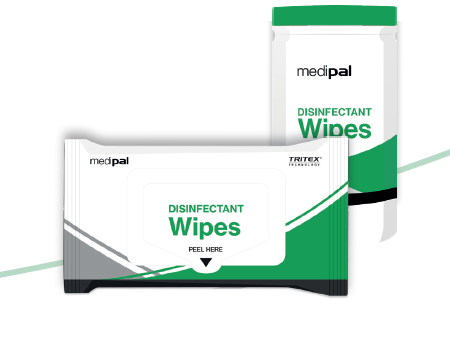Introduction
Disinfectant wipes play a critical role in infection prevention across healthcare settings. The medical device regulation reviews the products efficacy to ensure maximum effectiveness on medical devices. This white paper explores the significance of these two factors in preventing cross contamination, maintaining the best possible hygiene standards.
Understanding MDR Approval
Disinfectant wipes classified under MDR (EU Medical Device Regulation 2017/745) are subjected to rigorous (independent) testing, ensuring that the products meet stringent regulatory requirements related to performance and clinical evidence. For example: the wipe products we have that are MDR approved are supported by guidance published in EN 14885:2022.
Key Benefits of MDR Approval:
Validated Effectiveness – MDR-approved wipes must undergo independent stringent testing to confirm their antimicrobial properties.
Regulatory Compliance – Healthcare industries will benefit from choosing MDR-approved disinfectant wipes, this is due to the standards and legal obligations these products must adhere to.
Enhanced Trust and Reliability – MDR certification assures end-users that the wipes have been thoroughly vetted and validated.
Quality Assurance – MDR approval ensures that products are manufactured under strict quality control procedures to maintain consistency and reliability.
The Importance of Full Virucidal Efficacy
Viruses pose a significant threat to public health, as demonstrated by global pandemics such as COVID-19. The virucidal efficacy of disinfectant wipes depends on their active ingredients, their concentration, and the specific efficacy testing they undergo. Disinfectant wipes are tested according to EN 14885:2022, which sets standardised requirements for efficacy. Importantly, full virucidal efficacy can be achieved on both MDR and non-MDR disinfectant wipes, provided they meet the necessary testing criteria against both enveloped and non-enveloped viruses.
EN 14476 is the specific test method that determines a disinfectant’s efficacy against viruses. A product can be classified as effective against enveloped viruses, a limited spectrum of viruses, or as having full virucidal efficacy, meaning it can inactivate both enveloped and non-enveloped viruses.
However, using a fully virucidal wipe that is MDR-approved (Medical Device Regulation) offers additional benefits, particularly in healthcare settings. MDR-approved wipes undergo more rigorous regulatory scrutiny, ensuring they are not only effective against a broad range of pathogens but also meet stricter safety and user protection standards. This makes them more suitable for critical environments such as hospitals, where infection control is paramount and patient safety is a priority.
Advantages of Full Virucidal Wipes:
Broad-Spectrum Protection
Critical for Healthcare Settings
Supports Compliance with Infection Control Guidelines
Minimises Cross-Contamination Risks
Long-Term Cost Efficiency
Pal goes beyond standard requirements by testing products at the end of their shelf life to ensure consistent efficacy under real-world conditions.
The Risks of Using Non-MDR and Non-Virucidal Wipes
Using disinfectant wipes that lack MDR approval or full virucidal efficacy presents several risks:
Incomplete Pathogen Elimination – Wipes that are not fully virucidal may leave behind infectious viral particles, increasing the risk of disease spread.
Regulatory Non-Compliance – In our view, disinfectant wipes used on non-invasive medical devices should be MDR-approved, aligning with the regulatory requirements set by your national authority or notified body. MDR approval ensures that these wipes meet stringent safety, efficacy, and compliance standards, providing greater assurance in healthcare settings. Using non-MDR-approved wipes in these applications may pose regulatory and patient safety risks, making adherence to these standards not just a recommendation but a necessary safeguard.
Increased Infection Rates – Inadequate disinfection can contribute to higher infection rates, particularly in healthcare settings.
Device-Level Risk – The use of ineffective wipes on non-invasive medical devices may compromise infection prevention measures at the point of care. While unlikely to drive large-scale outbreaks, such lapses can contribute to localised infection risks and undermine overall hygiene protocols in clinical settings.
Industry Use Cases for MDR-Approved Virucidal Wipes
Healthcare Facilities
Hospitals, clinics, and long-term care homes use disinfectant wipes as part of their infection prevention protocols. While healthcare-associated infections (HAIs) are typically bacterial or fungal in origin, fully virucidal wipes play a vital role in broader hygiene practices, helping reduce the presence of viruses on medical equipment and surfaces. MDR-approved wipes offer reassurance that they meet rigorous, independently verified standards for safety and efficacy.
Conclusion
For disinfectant wipes to be a reliable tool in infection control, they must undergo rigorous testing to ensure efficacy against a broad spectrum of pathogens. While full virucidal efficacy is essential for combating viral threats, it is only one aspect of a comprehensive infection prevention strategy. Under EN 14885, disinfectant wipes, whether MDR or BPR are assessed for their effectiveness against various microorganisms, including bacteria, fungi, and spores, in addition to viruses.
However, MDR-approved wipes offer an additional layer of assurance. They are specifically designed and tested for use on medical devices, meeting stricter requirements. This ensures that while the wipes provide broad-spectrum efficacy, they also maintain the integrity of medical equipment and comply with stringent healthcare regulations.
Organisations and individuals should prioritise wipes that are both MDR-approved and tested against a wide range of pathogens to ensure compliance, effectiveness, and patient safety. Investing in wipes that meet these standards is not just a regulatory expectation, it is a critical measure for safeguarding public health, preventing cross-contamination, and maintaining operational continuity across healthcare and other high-risk environments.






